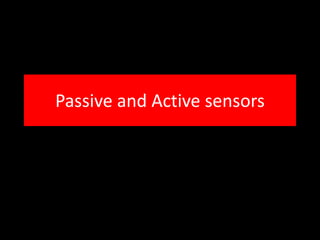Passive vs Active Remote Sensing Techniques
•Download as PPTX, PDF•
21 likes•17,446 views
Report
Share
Report
Share

More Related Content
What's hot
What's hot (20)
Applications of remote sensing in geological aspects

Applications of remote sensing in geological aspects
Viewers also liked
Viewers also liked (6)
Similar to Passive vs Active Remote Sensing Techniques
Similar to Passive vs Active Remote Sensing Techniques (20)
lecture3electromagneticspectrum-150106045802-conversion-gate02 (1).pptx

lecture3electromagneticspectrum-150106045802-conversion-gate02 (1).pptx
More from Vivek Srivastava
More from Vivek Srivastava (20)
Passive vs Active Remote Sensing Techniques
- 1. Passive and Active sensors
- 2. Passive sensors • Remote sensing systems which measures natural energy • Sun provides source of energy for remote sensing • Energy from sun is either reflected as is the case for visible wavelengths or absorbed and re- emitted as it is for infrared wavelength
- 3. • Remote sensing systems which measures naturally available energy are called passive remote sensing • Passive remote sensing can only take place when sun is illuminating the earth • Or no reflected energy available from the sun at night
- 4. • Energy which is naturally emitted (infrared) can be detected day or night provided energy should be emitted large enough to be recorded • Passive remote sensing is also possible in microwave region
- 6. Disadvantage • Passive sensors will work only during the day time as sun’s reflected energy is not available for illumination at night • Seasonal dependency
- 7. Active sensors • Active sensors provides their own energy source for illumination • Sensors emits radiations which is directed towards the target to be investigated • The radiation reflected from that target is then detected and measured by the sensors
- 8. • Its advantage is that we can obtain measurements anytime regardless of the time of the day or season • Another advantage is that active sensors can be used for examining wavelengths that are not sufficiently provided by the sun such as microwaves
- 9. • Active systems require the generation of a fairly large amount of energy to adequately illuminate the targets. Example is radar
